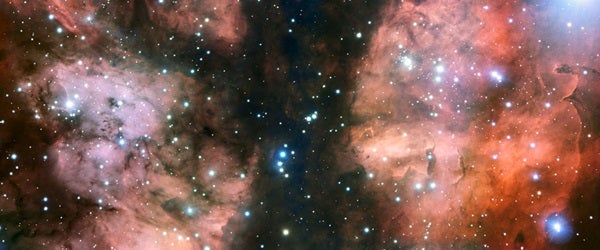Deep in the Milky Way in the constellation Scorpius the Scorpion lies NGC 6357, a region of space where new stars are being born of chaotic clouds of gas and dust. The ESO’s VLT has imaged the outer parts of this vast nebula, producing the best picture of this region taken so far.
The new picture shows a broad river of dust across the center that absorbs the light from more distant objects. To the right, there is a small cluster of brilliant blue-white young stars that have formed from the gas. These are probably only a few million years old, very young by stellar standards. The intense ultraviolet radiation streaming out from these stars is hollowing out a cavity in the surrounding gas and dust and sculpting it in strange ways.
The whole image is covered with dark trails of cosmic dust, but some of the most fascinating dark features appear at the lower right and on the right-hand edge of the picture. Here the radiation from the bright young stars has created curious elephant-trunk columns, similar to the famous “Pillars of Creation” in the Eagle Nebula (M16). Cosmic dust is much finer than the more familiar domestic variety. It more closely resembles smoke and consists mostly of tiny particles of silicates, graphite, and water ice that were produced and expelled into space by earlier generations of stars.
The bright central part of NGC 6357 contains a cluster of high-mass stars whose inhabitants are among the brightest in our galaxy. This inner region, not seen in this new picture, has been much studied and imaged by the NASA/European Space Agency (ESA) Hubble Space Telescope. But this new picture shows that even the less well-known outer parts of this nursery contain fascinating structures that can be revealed by the power of the VLT.










